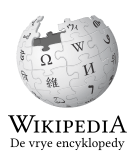Dutch Low Saxon Wikipedia
The Neadersassiske Wikipedia, the Dutch Low Saxon edition of Wikipedia, was started on 24 March 2006. It collects articles written in any Low German dialect indigenous to the Netherlands, as well as a small number of articles in varieties of Low German from Germany. As of June 2020, this edition has about 7,100 articles. Among other features, there are spoken articles, "showcased" articles and provincial portals.
 | |
Type of site | Internet encyclopedia project |
|---|---|
| Available in | Dutch Low Saxon |
| Headquarters | Miami, Florida |
| Owner | Wikimedia Foundation |
| Created by | Dutch Low Saxon wiki community |
| URL | nds-nl.wikipedia.org |
| Commercial | No |
| Registration | Optional |
The Dutch Low Saxon Wikipedia has been cited in the Dutch press, and Low Saxon institutes in the Netherlands have noted it and contributed to it.[1][2][3]
Characteristics
Dutch Low Saxon has traditionally been an oral set of dialects exclusively, with a modest literary tradition existing since the 19th century. Given that the vast majority of speakers never write in the language, the fairly sizeable number of speakers is not a good indicator of the potential for attracting contributors to the Dutch Low Saxon Wikipedia. A handful of contributors, with little variation over the years, has sustained this edition of Wikipedia since its inception, also staying on top of the vandalism which, although low-key, occurs with some regularity.
Many of the articles, for instance on Dutch Low Saxon writers, do not exist in any other edition of Wikipedia. Existing illustrations on Wikimedia Commons are usually linked to illustrate articles. According to the list of Wikipedias, the Dutch Low Saxon Wikipedia has a relatively large number of edits and images and above-average article depth for Wikipedias that have between 1,000 and 9,999 articles (depth of 23 compared to a mode of 8, a median of 11 and a mean of 18).[4]
History
The Dutch Low Saxon Wikipedia was preceded by three years by a Low German (Plattdüütsch) one.[5] The Low German dialects (which are not standardised) stretch from all of Northern Germany to the Northeast Netherlands. In practice, however, the Plattdüütsch Wikipedia was a German undertaking, following German-based spelling conventions. This spelling, combined with the growing divide since modern times between Dutch and German plat(t) due to the influence of the Dutch and German standard languages respectively, left a gap to be filled.
The eventual creation of a Dutch Low Saxon Wikipedia was delayed for many months due to discussion on whether this collection of dialects – recognised and protected by the Dutch government in the framework of the European Charter for Regional or Minority Languages – merited their own Wikipedia. Proponents made the case that the Dutch varieties are too different from the German ones – at least in writing – to be gathered under the same roof. Some vocal opposition centred on the question of whether the often rather distinct Low Saxon dialects spoken in the Netherlands could be taken as a whole and accommodated within one Wikipedia. The same countrywide grouping, however, had been opted for in the case of the Plattdüütsch Wikipedia.[6]
Throughout its existence, the number of structural contributors to the Dutch Low Saxon Wikipedia has remained low, with active and virtually fallow periods alternating. Up to four or five users are active in more active periods. Most of the structural contributors have administrator rights. The scarcity of committed writers has remained characteristic in spite of several attempts to boost their number, for instance through appeals on radio shows to which individual contributors have been invited.
The frequency of vandalism - creation of nonsense articles, removal of content, disparaging remarks - has varied, it sometimes being a daily occurrence and at other times occurring little. Vandalism is normally remedied within the day, often within hours or minutes.
Accommodation of the various dialects
Once created, the Dutch Low Saxon Wikipedia took off well, with arrangements being made to accommodate the dialect subgroups and their different spelling conventions (there are several established spelling systems[7]). Each contributor can write in their own dialect, categorizing an article in accordance with the dialect used. If the article is a stub, another contributor can expand it and adapt it to their own dialect. If the article is longer, a further contributor using a different dialect will ask for their alterations to be rendered into the original dialect.
Another feature is that many articles on animals, plants, objects and activities include an overview of what is often a plethora of local names, differing per region and even per town.
References
- Article from the regional Dutch newspaper de Stentor (Dutch)
- Article from the Stellingwarfs foundation Stellingwerfs Eigen (pdf, Low Saxon) Archived 2008-02-16 at the Wayback Machine
- Mention by the Drèents foundation Drentse Taol (Low Saxon) Archived 2007-10-09 at the Wayback Machine
- List of Wikipedias (retrieved 26 October 2007)
- The Plattdüütsch Wikipedia, started in April 2003 (Low Saxon)
- Requests for new languages/Wikipedia Dutch Low Saxon
- For instance the Drentse spelling, approved by the Provincial States of Drenthe. Several other spelling systems are backed by regional institutions which often subsidise publications in Low Saxon.
External links
| Low Saxon edition of Wikipedia, the free encyclopedia |
- (Dutch Low Saxon) Dutch Low Saxon Wikipedia
- (Dutch Low Saxon) Dutch Low Saxon Wikipedia mobile version (Homepage not yet configured)